Chiang Mai, also called “Rose of the North,” is one of the most famous and historical cities in the north of Thailand (5). While taking a stroll through a local village and embracing ancient customs, you will fall in love with the city. Are you ready to learn more? Let’s consider, what is Chiang Mai known for?
The city is well known for its picturesque sceneries, historical monuments, and Thai culture. Chiang Mai is home to festivals, temples, safaris, waterfalls, tribal villages, and traditional cuisine. The city is also known for having family-friendly hospitality, couple culture, and pleasant weather.
While planning your first or next trip to Chiang Mai, it is essential to consider all possible activities and traditions you could explore. The city is a space for all; solo travelers, couples, and families.
What Is Chiang Mai Famous For?
1. Pleasant Weather
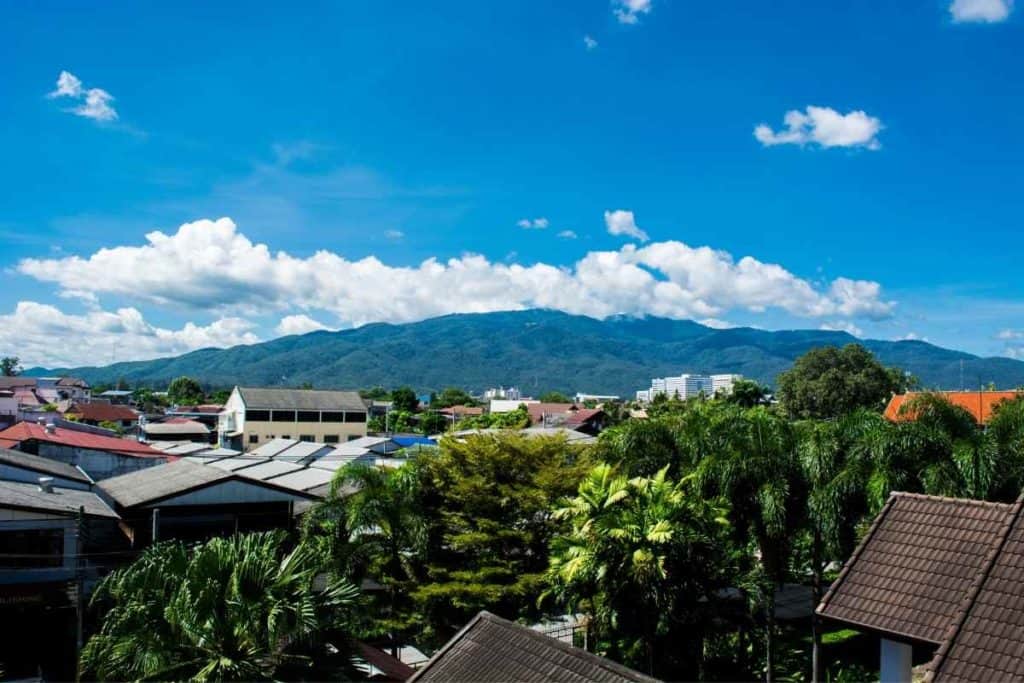
Chiang Mai is firstly known for its pleasant weather compared to other cities in Thailand. Due to mountain peaks, Chiang Mai’s weather is relatively cool. The ideal time to visit the city is between October and April, when there is a slight breeze (1). The city is also most vibrant during destinations and seasonal events.
However, November to February is also an ideal time to visit Chiang Mai. The weather is perfect for outdoor activities, where you will only need to carry a jacket during the night. November is also populated due to Loi Krathong festivities and the Chiang Mai flower festival in February. In January, the city gets rather busy with a high increase in tourism (1).
March to May is the start of summer; tourists get good deals on flights and hotel bookings. Although the temperature can reach relatively high during this period, you can always relax by the pool or carry sunglasses to make the most of the summertime (1).
One of the few months that may not catch your eye would be from June to the start of October. These months pave the way for the rainy season and rise in humidity (1). Your vacation would instead be interrupted by showers, raincoats, and umbrellas.
2. Yi Peng Lantern Festival
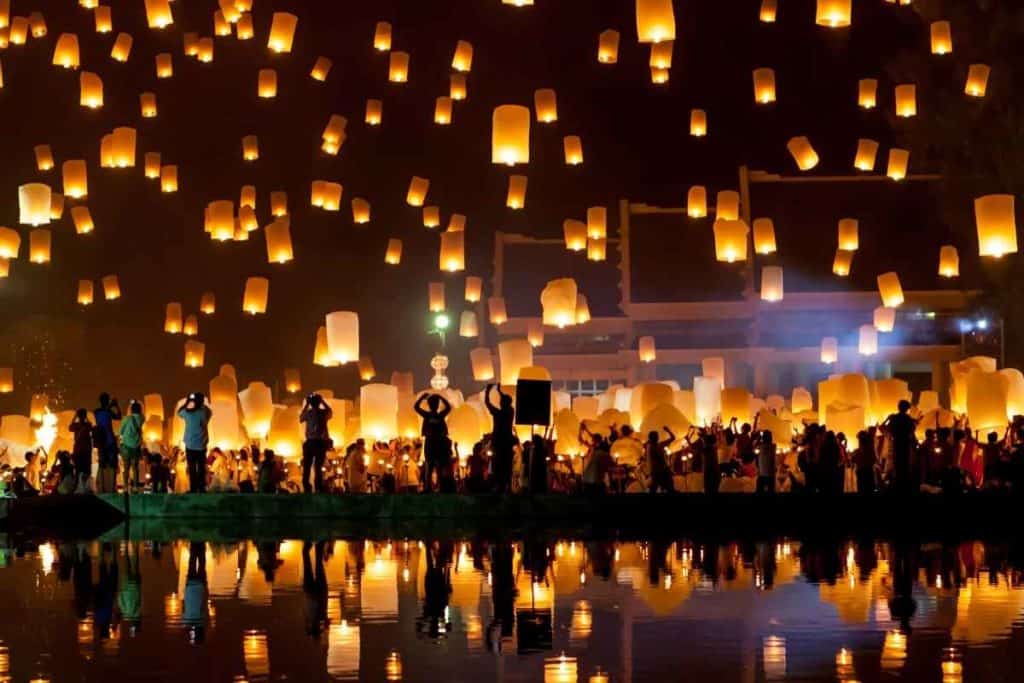
In mid-November, the Yee Peng Festival is celebrated on the full moon of the twelfth lunar month every year. Thousands of lanterns are lit into the night, sky-creating beautiful sceneries and images for the iconic night (6).
There is more to the history of Yee Peng than a regular lantern sky. The act of releasing lanterns and Krathong symbolizes letting go of misfortunes from the previous year. Buddhists of the majority population in Thailand believe that whatever wish you make while setting off your lantern will come true (6).
Several other activities happen in Chiang Mai, including Thai dance performances and the official Yee Pang Parade around the Old City gate and Tha Phae Road. You can expect live music, handicrafts, fireworks, and many tourists (6).
3. Animal Sanctuary and Night Safari
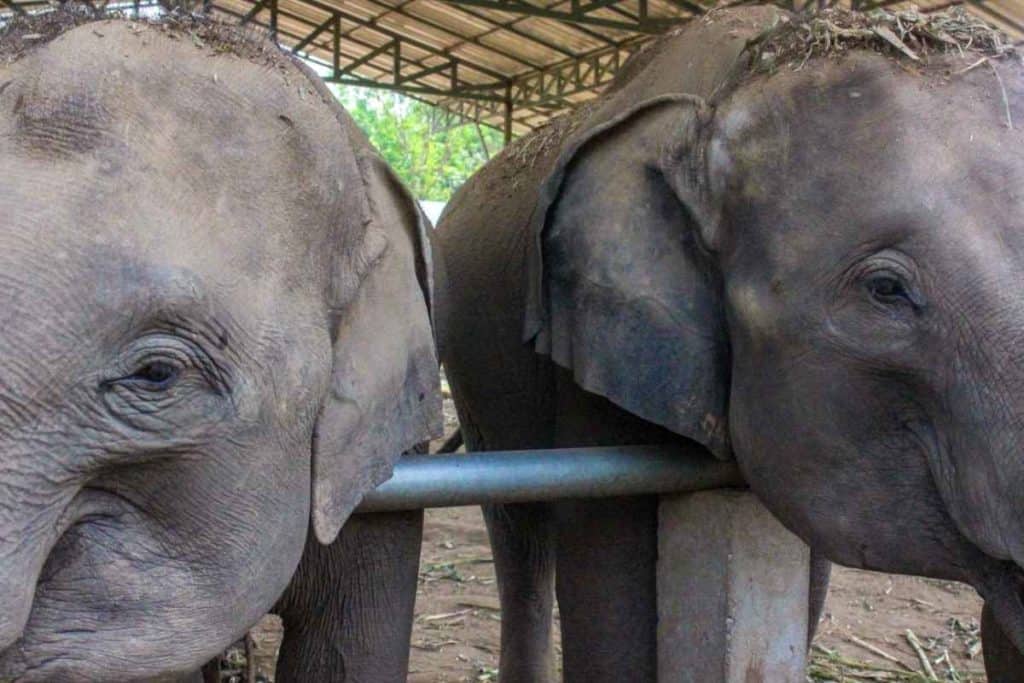
Chiang Mai is also a paradise for animal lovers. You can book private tours and even volunteer at sanctuaries. The top picks for tourists include the ethical elephant caretaker and Doi Suthep temple private tour starting at $125 per person (4).
Another popular attraction is the Chiang Mai Ethical elephant observation experience. If, however, you would like to volunteer in a small group, Chiang Mai offers a multi-day trip to the elephant retirement park (4).
4. Tribal Villages
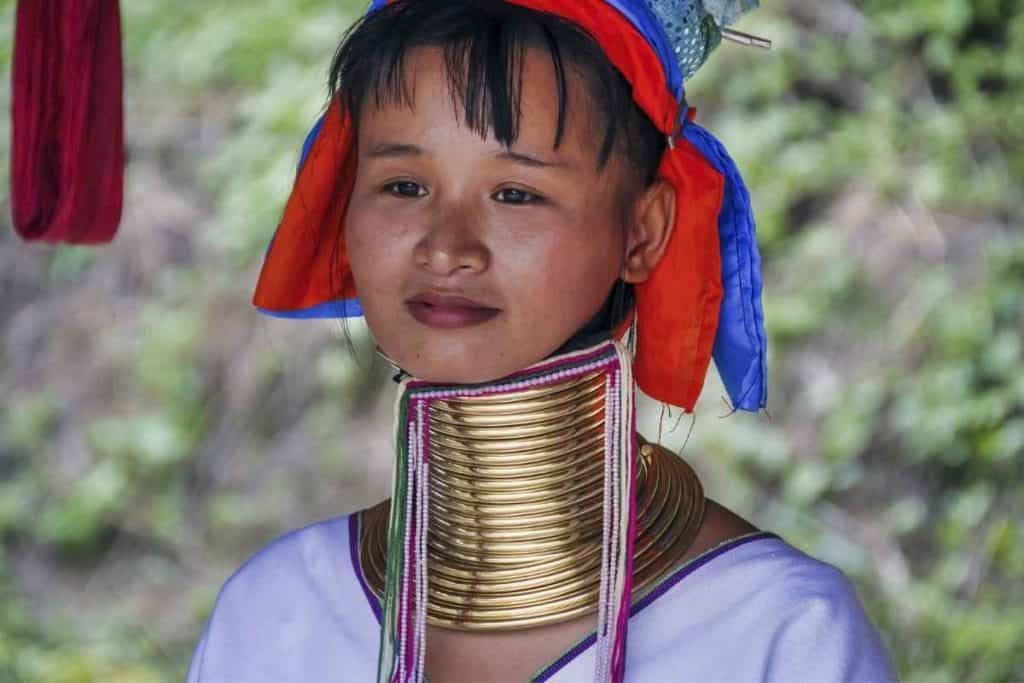
Indigenous tribal villages are yet another reason to visit the culturally unique city. The city’s areas have been dotted with tribal villages of Thailand’s ethnic minorities. Let’s look into some of these villages and why they are historically embedded in Thai history.
Karen Village:
Known with connections to Myanmar, the Karen Village is the largest group in Thailand, with approximately half a million. The subgroups are also called Padaung or Long Neck Karen. The women are particularly notable for the brass rings around their necks (2).
Lahu Village:
Also famous is the Lahu Village, known from the Tibetan highlands. Houses are built on high stilts with a central temple where people worship. Women in this region wear black and red jackets while the men wear don baggy green pants (2).
Mein Village:
The Mein tribe is also known as the Yao and traditionally comes from China. This tribe is known for silversmithing and embroidery and wearing long black jackets, red lapels, and embroidered pants (2).
Hmong Village:
In northern Thailand and near Southern China, Hmong people are known as independent groups. The people live in the mountains and are known for their hemp batik pleated skirts (2).
Akha Village:
This village is marked by ceremonial gates and houses built on slow slits with pitched roofs. The people are well-known for wearing headdresses that are decorated with silver coins, seashells, and a red taffeta (2).
Lisu Village:
From eastern Tibet, Lisu village is located between Chiang Mai and Mae Hong Son. The people live in bamboo houses, and women often wear traditional knee-length tunics and colorful hats (2).
5. Street Food
Thai food is famous for its spiciness and unique flavor. Especially in northern Thailand and in the district of Chiang Mai, food takes on amazing inspiration from neighboring countries such as Burma and China.
If you are traveling to the country’s north, make sure that you stop in Chiang Mai for delicious cuisine. Chiang Mai is praised for its flavorful dishes sold around night bazaars. Whether you opt for vegetarian options or a meat course, you will not be disappointed by Chiang Mai’s variety.
Let’s take a look at the most popular cuisines found in Chiang Mai:
Khao Soi (Egg noodle curry):
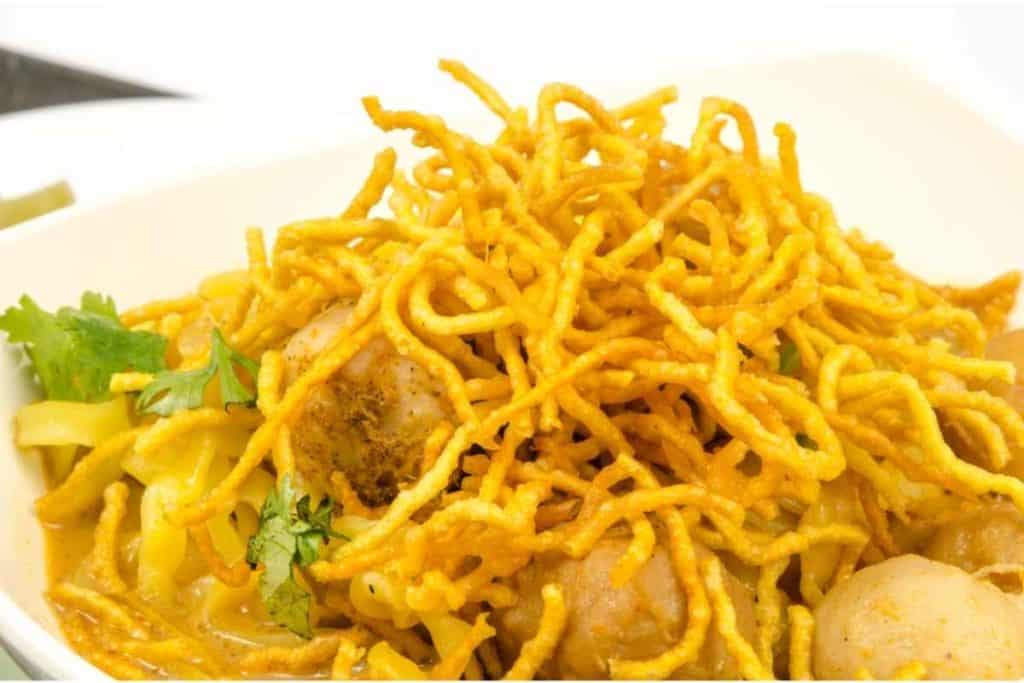
Known as a popular dish in northern Thailand, you can order Khao Soi in beef, pork, or chicken. The Burmese-influenced dish translates to ‘cut rice’ and is made of deep-fried egg noodles dipped in a coconut milk soup (3).
The dish also includes lime, shallots, cilantro, pickled mustard, chili paste, and ginger. Made in various spice ranges, you can enjoy traditional Lanna-style khao soi in Chiang Mai. A popular local favorite is at 91 Charentes, Fakharm, Mueang Chiang Mai (3).
Khanom Chin or Khanom Jeen:
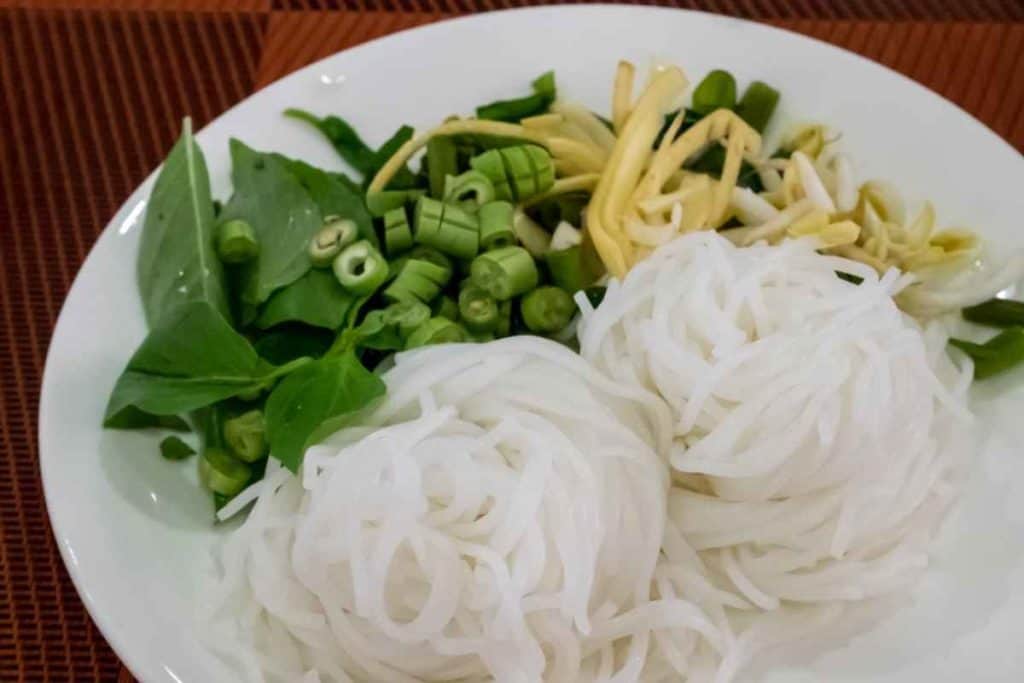
Chiang Mai’s Warorot Market is swarming with stalls that serve new Khanom chin. You will notice that this cheap dish is made of thin rice noodles. You can choose the soup you would like to add to the noodles (3).
For example, chicken in coconut curry soup, pork blood soup, or fish balls in curry soup. These noodles are then mixed in fermented rice vermicelli. The dish is also called “Thailand’s version of spaghetti”. Additionally, you can pay 10 Baht for egg toppings (3).
Sticky Rice:
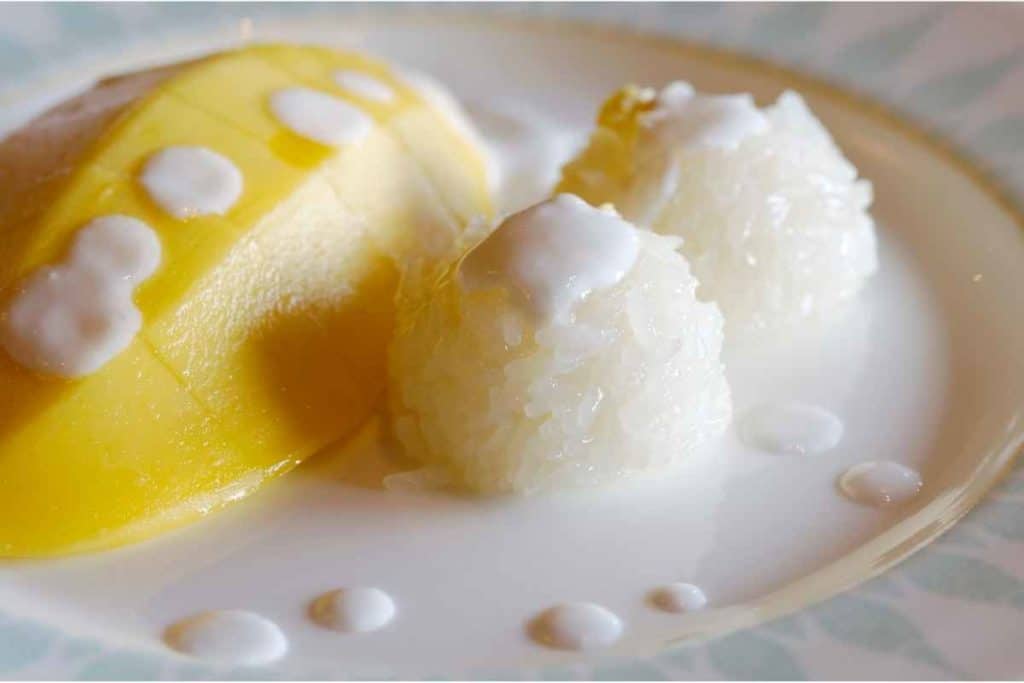
Chiang Mai street food also takes inspiration from the Philippines regarding their sweater dishes. Sticky rich is usually wrapped in banana leaves served with fruit and coconut. Violet rice, beans, and egg custard are also added to give additional flavor and color to the dish (3).
Sai Oua (Grilled spicy herb sausage):
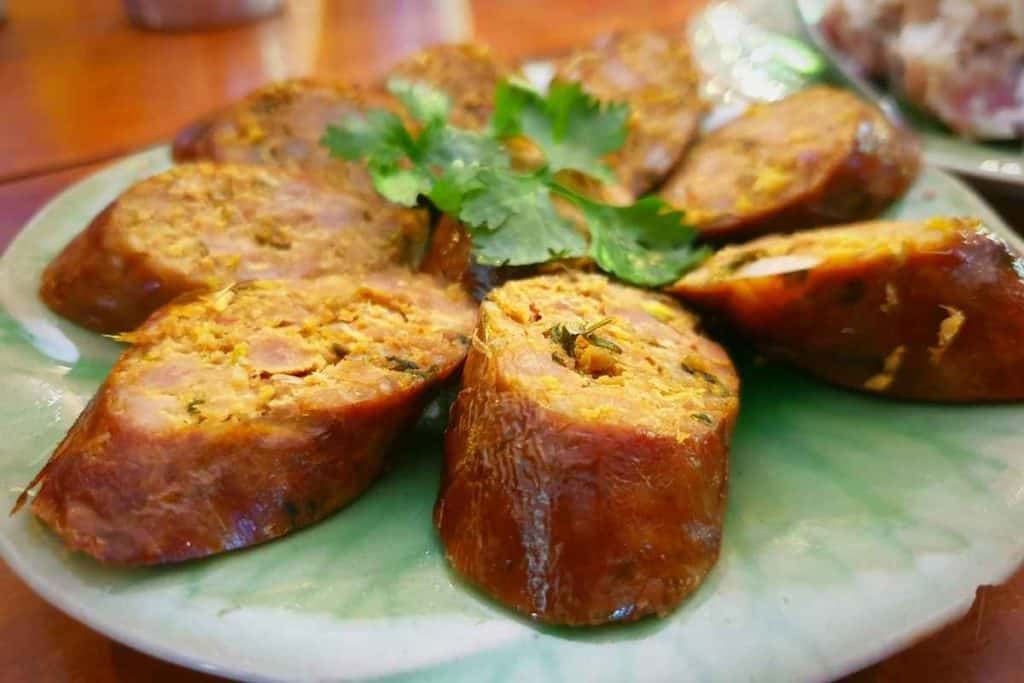
Another popular street favorite is meatballs on a stick. These northern-style Thai sausages are hot and spicy. Made from ground pork, the Sai Oua is filled with delicious species such as shallots, pepper, lemongrass, cilantro, galangal, and dried chili (3).
Pad Thai:
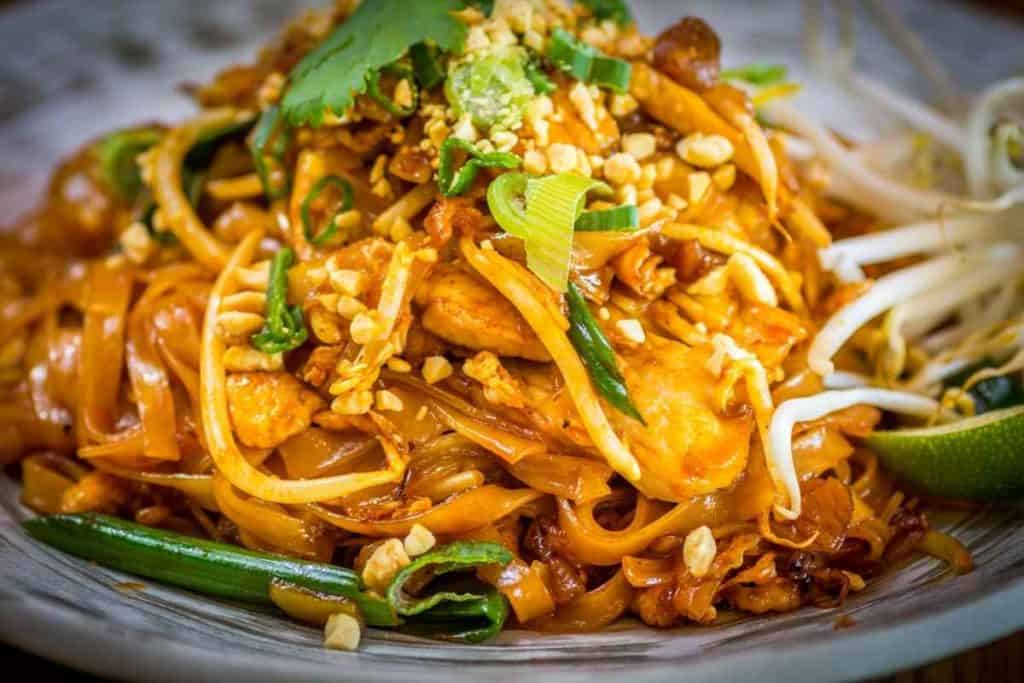
It is no doubt that Pad Thai is a popular dish all around the country. You can find it all around Thailand but tasting the dish in Chiang Mai is even more impressive. Street corners and restaurants all serve the dish in unique ways (3).
Fried Quail Eggs:
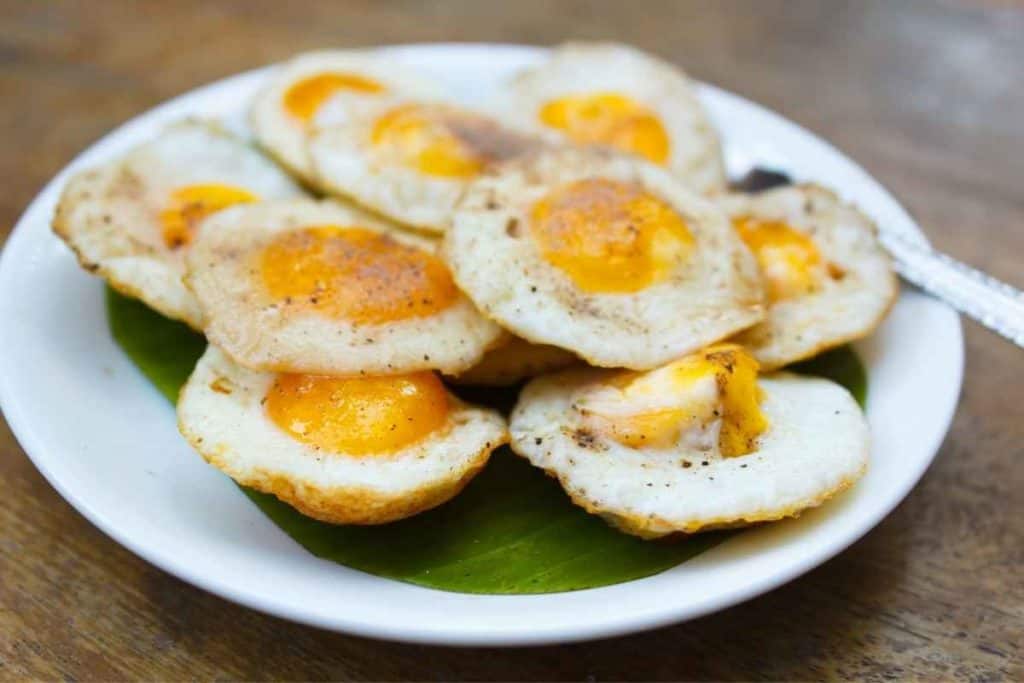
Another classic food stall dish is the fried quail egg. The eggs are mixed in coconut milk, fish, and soy sauce. The dish is neither spicy nor sweet. It is the perfect dessert for travelers coming to Chiang Mai for the first time (3).
Son Tam or Som Tum (Green papaya salad):
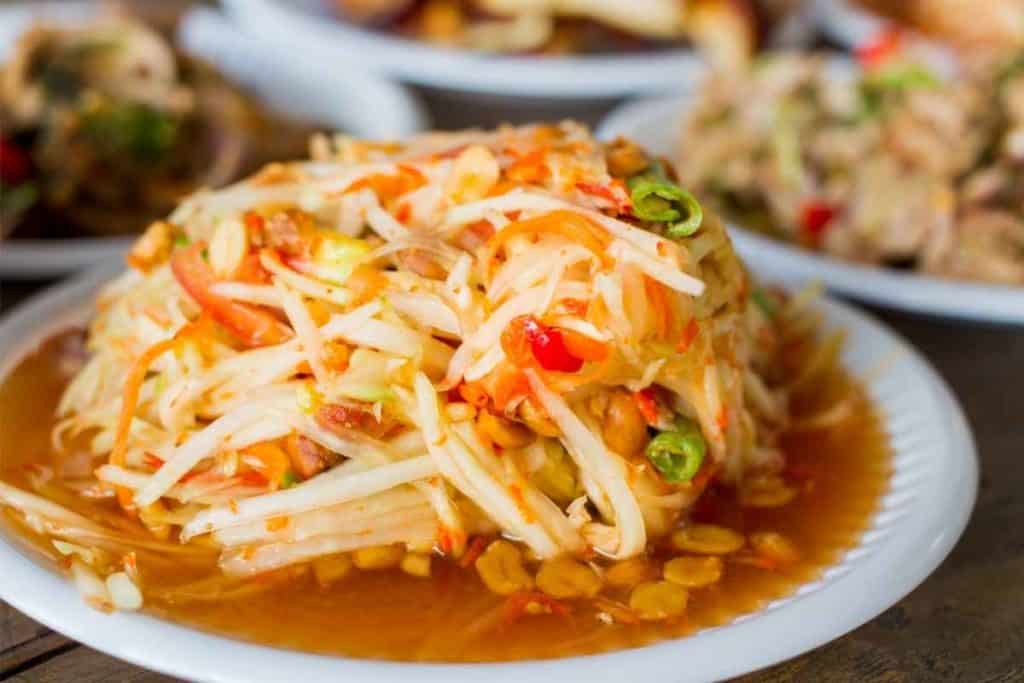
Shredded green papaya is a popular cuisine option for travelers in Chiang Mai. The salad is served with chili, tomatoes, and garlic. Additionally, the salad incorporates a wide range of flavors and ingredients. By paying around 5 to 10 more Baht, you can also get extra seafood added to the papaya salad (3).
Kaeb moo (crispy pork rinds):
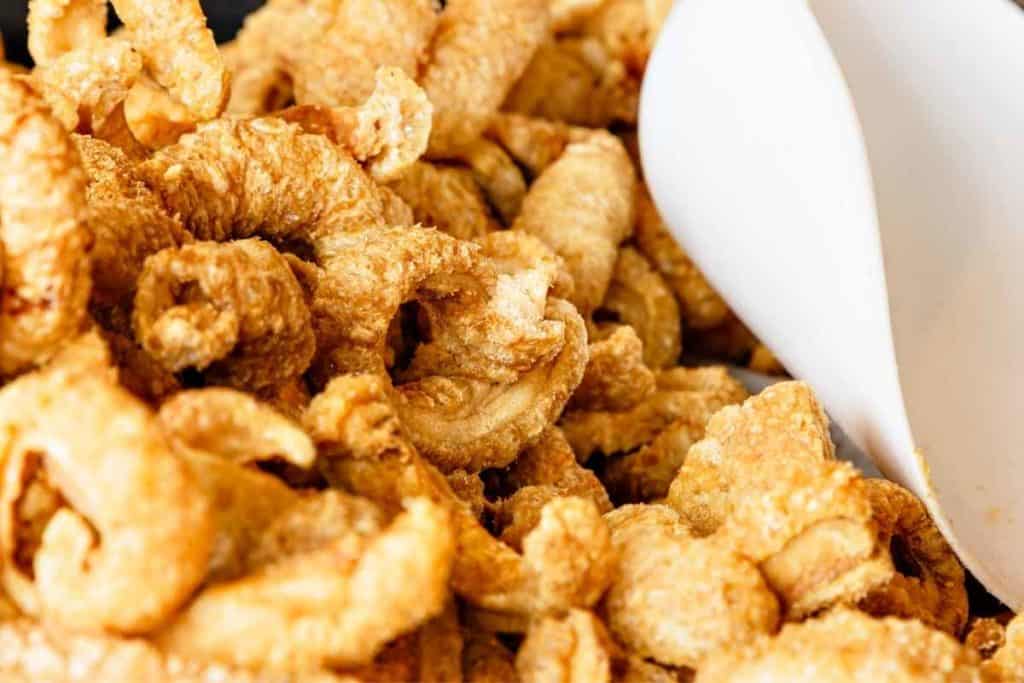
Another classic Philippeans dish served in Chiang Mai is the Kaeb Moo. The crispy fried pork is mixed in with salt and garlic. Moreover, you can find different variations of this dish, for example, curls of crunchy skin or rinds with a part of fat with high cholesterol levels (3).
Grilled pork, fish, and chicken:
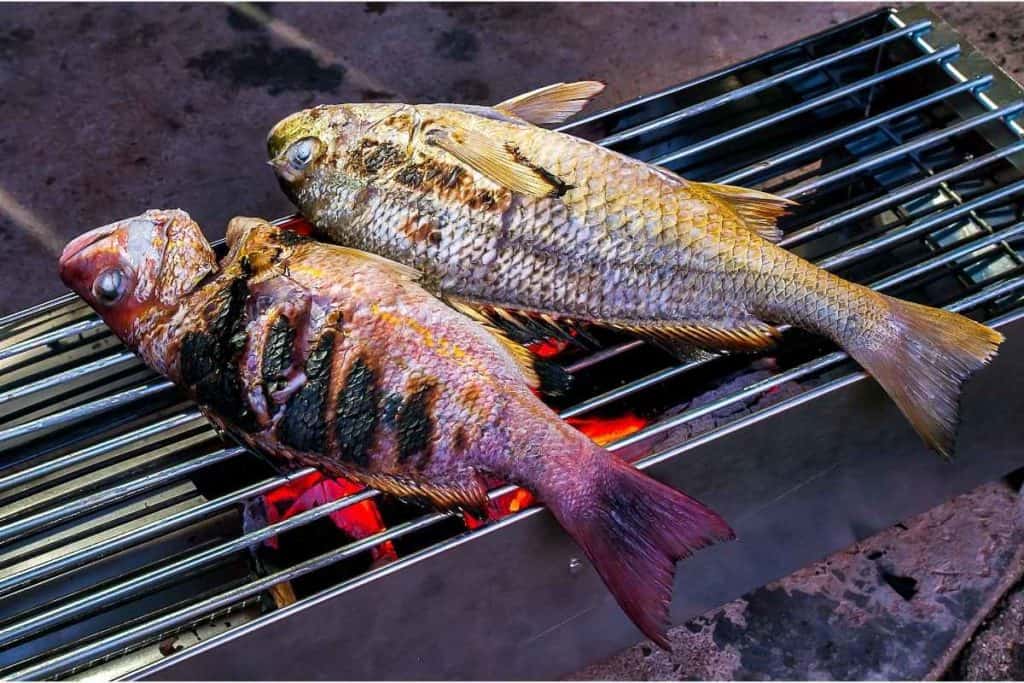
You will see a lot of varieties of meat on sticks as you walk through the streets of Chiang Mai. However, vendors also serve large portions of crushed pork, chicken, and fish. With seasoning and chilies, you can find a delicious large meal at a low price. Prices can vary, but chopped meat parts usually cost around 50 to 80 Baht (3).
Exotic finds:
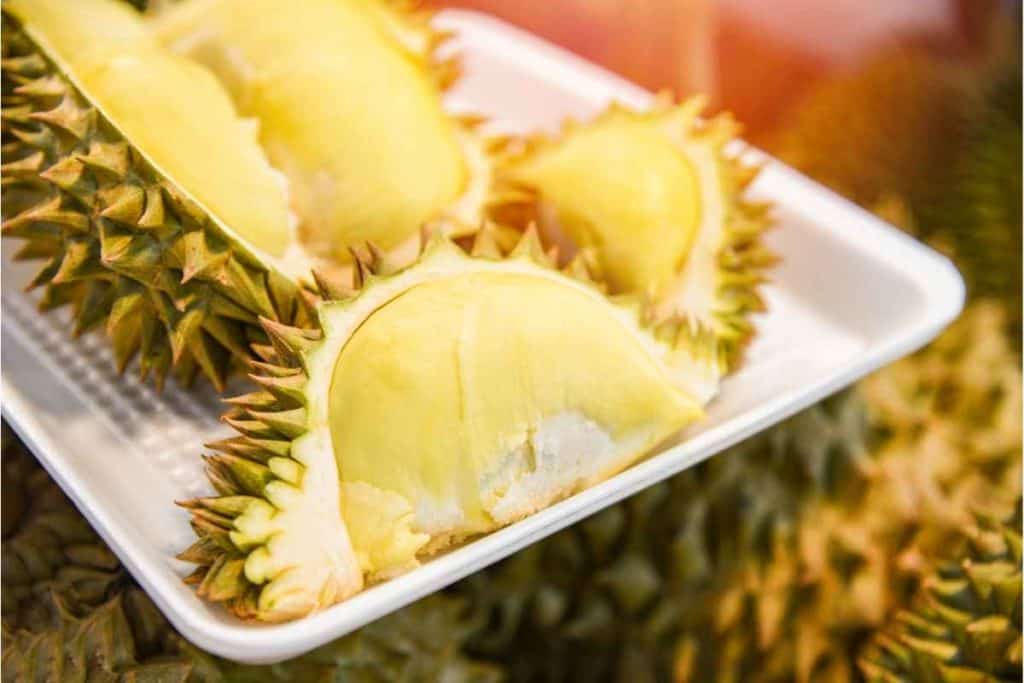
Chiang Mai is well-known for its unique, diverse food options. For example, you can find a lot of locals eating grasshoppers, crickets, dried lizards, silkworms, bats, and ant eggs in the city. Other unique options include Asian fruits such as durian, lanzones, jackfruit, mangosteen, rambutan, dragonfruit, and sugar apple (3).
Conclusion
There is no doubt that Chiang Mai is a unique city known for its various talents and traditions. Whether you opt for a short or long trip, you will not be disappointed by what’s in store.
Chiang Mai is well-known for its cool weather, the lantern festival, animal sanctuaries, local villages, and Thai cuisine. When traveling, you will undoubtedly experience a different side of Thailand compared to the larger and more populated cities.
Like always, if you want to discover more about Thailand, stay guided with ThaiGuider. You might learn something you never knew about this unique country.
References
1. MakeMyTrip. Best Time To Visit Chiang Mai. MakeMyTrip. [Online] [Cited: March 10, 2022.] https://www.makemytrip.com/travel-guide/chiang_mai/best-time-to-visit.html/.
2. Viator. Chiang Mai Hill Tribe Villages. Viator. [Online] [Cited: March 10, 2022.] https://www.viator.com/en-SG/Chiang-Mai-tourism/Chiang-Mai-Hill-Tribe-Villages/d5267-t19729/.
3. Adalid, Aileen. Chiang Mai Street Food: 10 Dishes You Must Try (Thailand). I Am Aileen. [Online] [Cited: March 10, 2022.] iamaileen.com/chiang-mai-street-food/.
4. GetYourGuide. Chiang Mai Safaris & Wildlife Activities . GetYourGuide. [Online] [Cited: March 10, 2022.] https://www.getyourguide.com/chiang-mai-l271/safaris-wildlife-activities-tc40/.
5. O. 10 Reasons Why You Must Visit Amazing Chiang Mai. Vespa Adventures. [Online] 2019. [Cited: March 10, 2022.] vespaadventures.com/10-reasons-why-you-must-visit-amazing-chiang-mai/.
6. Cindy. Top 10 FAQs Help You Know Yi Peng Lantern Festival Chiang Mai. Asia Highlights. [Online] March 1, 2022. https://www.asiahighlights.com/thailand/loy-krathong-festival/chiang-mai-yee-peng-festival/.
THINKING ABOUT A TRIP TO THAILAND?
I am working on a FREE Thailand Travel Guide with a FULL 7 Day Itinerary. Be the first to receive it!
Thank you for signing up.
Something went wrong.
